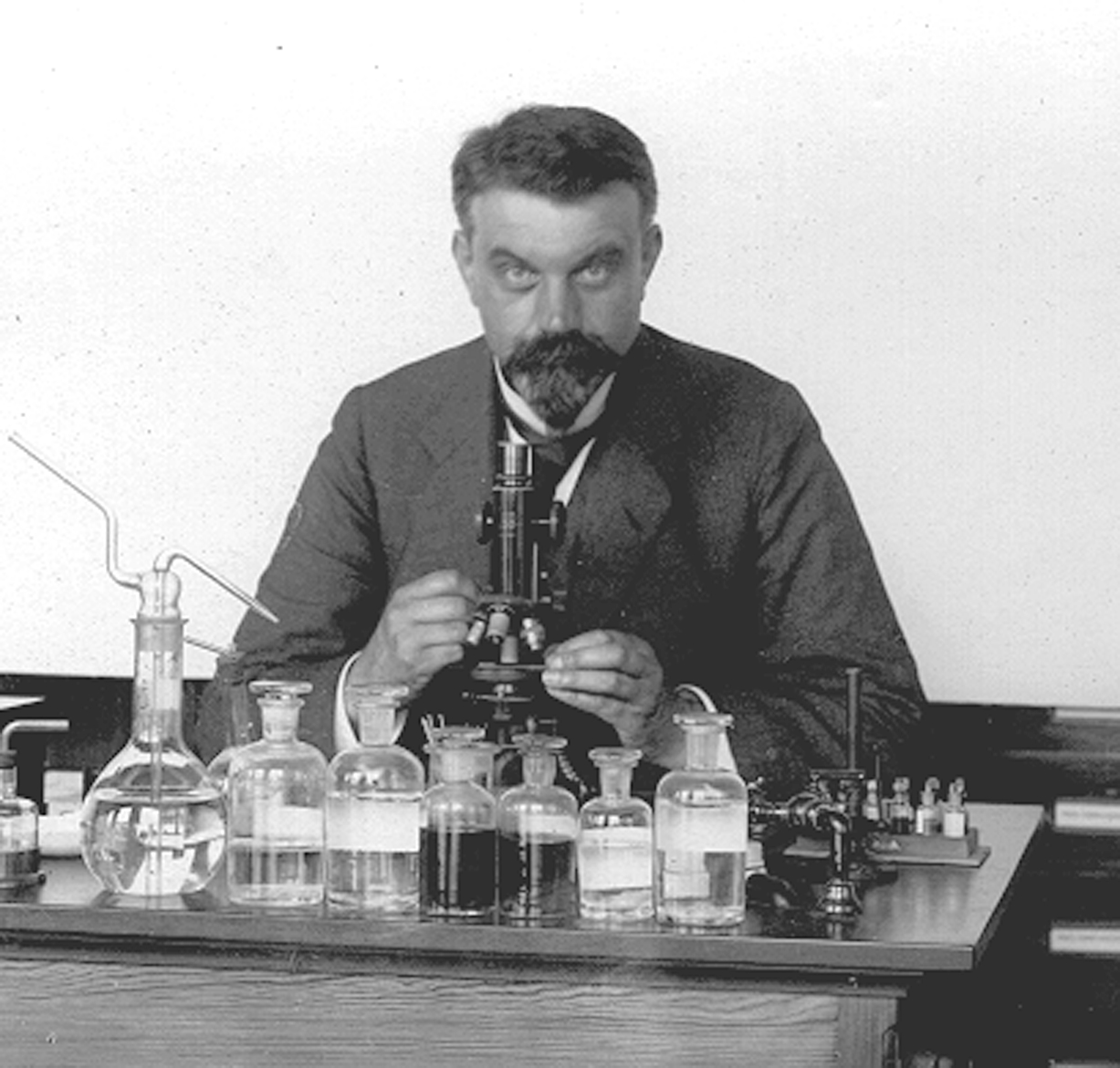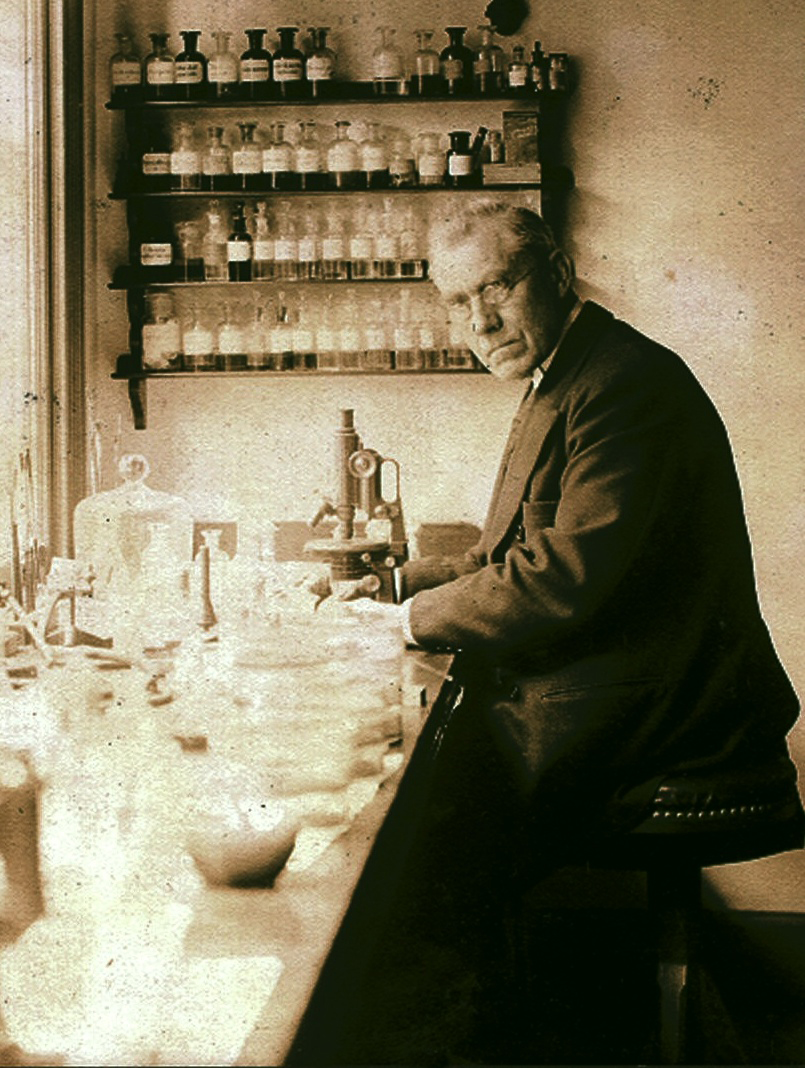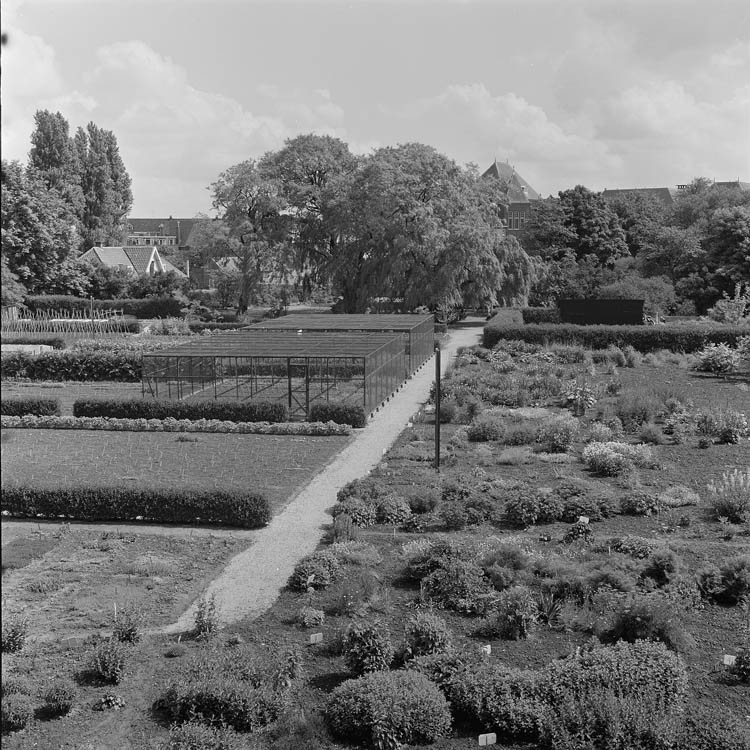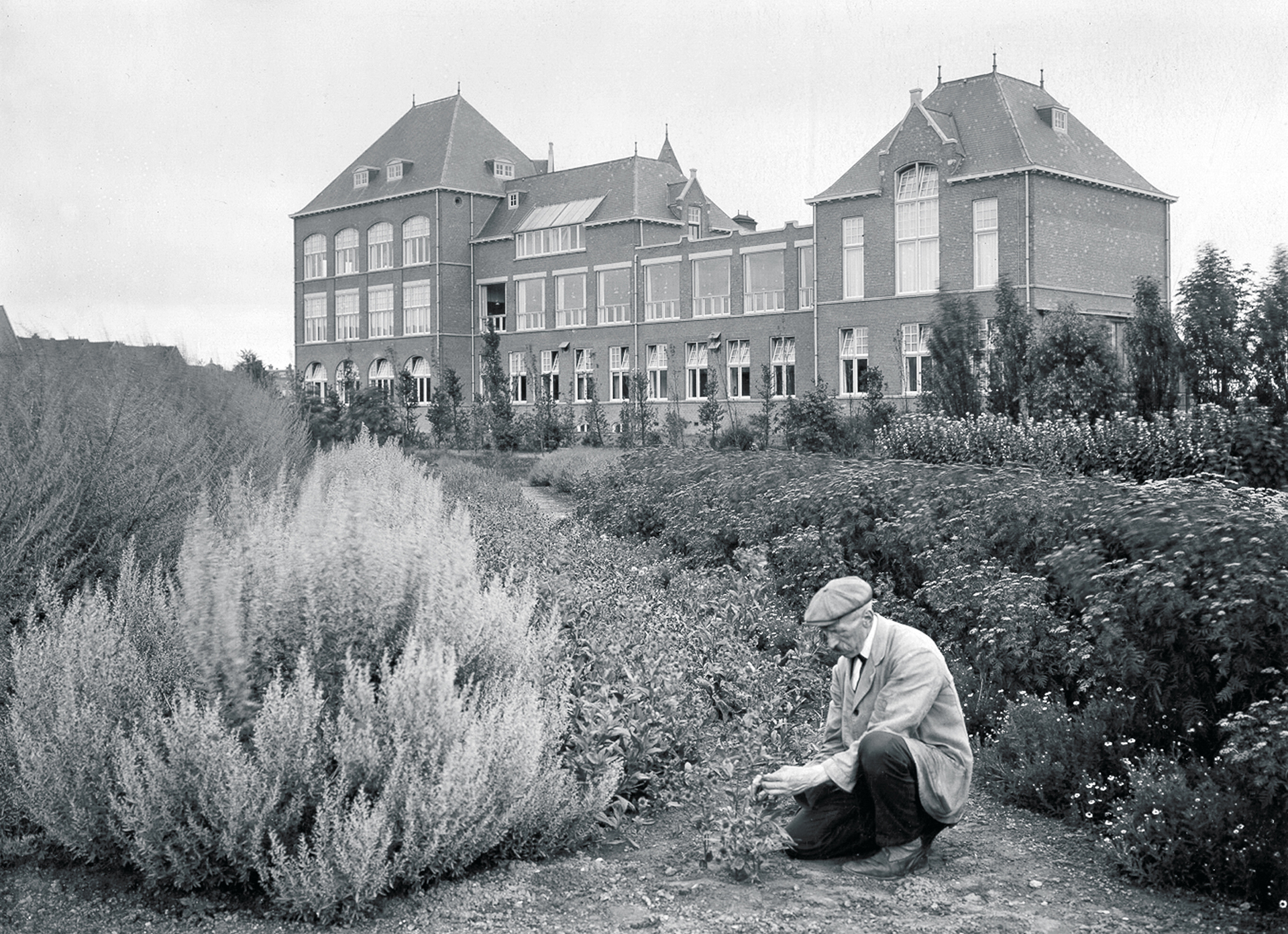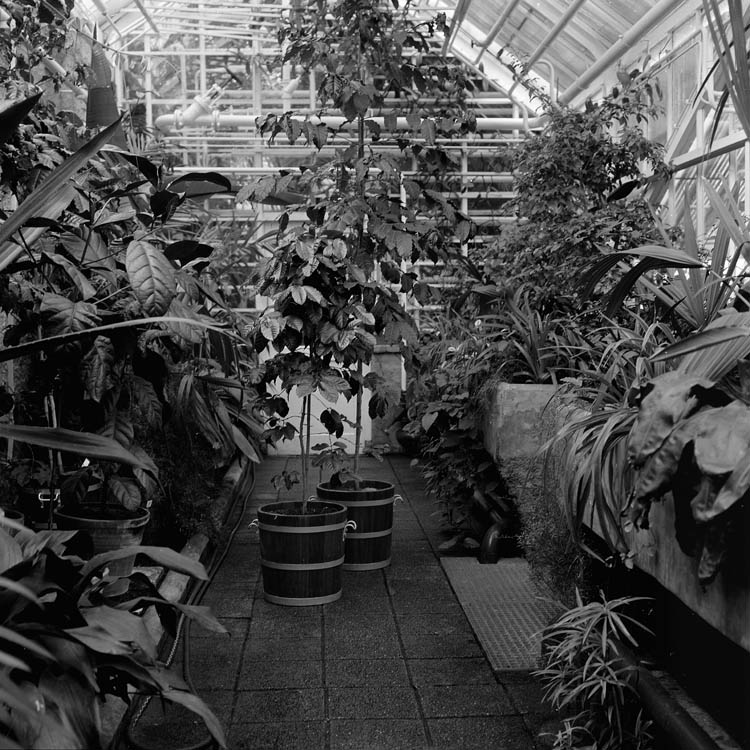History
The history of the TU Delft Hortus Botanicus is closely connected to the agriculture of our former largest colony, the Dutch East Indies, and to Gerrit van Iterson Jr. (1878-1972), who was in charge of the Delft garden from 1917 to 1948. From 1880 to 1910 scientific interest in tropical agriculture increased greatly. Initiated by the famous botanic garden in Buitenzorg (now Bogor) a network of testing stations emerged where a broad range of scientific research was conducted. Especially large-scaled crops, like coffee, sugar, tobacco, rubber, and tea, were targeted, but influenced by increasing ‘ethical colonial politics’, crops that the native population traditionally had cultivated were also given scientific attention.
During this period of increasing interest in tropical botany, Van Iterson got his first degree, from what was then still called the Polytechnic School, in 1901. In addition to the usual curriculum he also took two courses which brought him into contact with two illustrious Delft professors: M.W. Beijerinck, the founder of modern microbiology, and H. Behrens, who taught microchemistry.
In 1902 Van Iterson got an assistantship with Beijerinck and six years later he received his doctorate cum laude with a thesis strongly characterized by higher mathematics. It received excellent reviews and continued to be cited even in the 1970s.
-
In 1905 M.W. Beijerinck received his own laboratory and residence from the Polytechnic School at the Nieuwe Laan. He had high hopes for his brilliant graduate student and using his influence saw to it that in 1907 Van Iterson became professor of microscopic anatomy, a new subject in Delft. Van Iterson was given the required space for his lectures In Beijererinck’s laboratory and also got permission to make use of the garden and its plants.
Microscopic anatomy was not a required course in Delft, but nevertheless, Van Iterson’s lectures at the Nieuwe Laan were extremely popular. As a result, the laboratory at the Nieuwe Laan quickly became too small. In the summer of 1908 the young professor was given a place of his own, the old Magistrate Court building at no.81, Oude Delft. The building also had a garden that was made suitable for plants necessary for teaching and research. Van Iterson preferred plants that could be used for technology and thus laid the foundations for the study he would later call ‘Technical Botany’. -
The building and especially the garden at the Oude Delft were too small for the research Van Iterson had in mind. Barely a year later, he insisted on having his own laboratory specifically equipped for his studies. In 1908 he formulated the need for a culture garden as follows:
‘If the future engineer wants to fully understand the processes that are required to obtain the so important products from the vegetable kingdom, he must be given the opportunity to study the crops that are the starting point for this, as they are offered to technology, that is to say, in most cases in living condition... By its very nature, such a garden at a technical college need not be of a very large size, but it must nevertheless be of such a size that when it is used for the study of certain processes, a culture can be grown on a somewhat extensive scale.’
The curators of the Polytechnic School supported Van Iterson's request to the minister and labelled the construction of a new laboratory as 'urgent'. However, with the conservative government of that time the proposal stood little chance. Some changes were made to the house, the government made an extra plot of land available behind the house and a small greenhouse was built in the garden.
-
Permission for building a new laboratory and an experimental garden was postponed again and again. That changed in 1911 when Van Iterson was made a tempting offer to become director of the Java Sugar Industry testing station at Pasoeroean. When he began to seriously consider this, both the administrators and students took joint action. They asked the minister to see to it that Van Iterson and his research would not be lost for Delft. This time the minister’s response was positive and he asked Van Iterson to stay. He later stated that it was mainly the students' request that had convinced him.
After some hesitating Van Iterson finally decided to stay in Delft. He did so, however, on condition that he would get his own institute for teaching and research very soon. This was promised, but the actual realization still took some time and effort. -
Van Iterson had to have a lot of patience before his Culture Garden finally came into being. Official mills simply grind slowly. When he proposed to orient himself abroad for the construction and furnishing of the new laboratory, the ministry refused. After quite some struggle it was finally approved, but in as modest a form as possible. The decision to buy a piece of land was also postponed again and again. In April 1914 the time had finally come and the Polytechnic School was given land for the garden.
It was probably not exactly what Van Iterson had expected. The site was located south of the Schie in what is now still called the Wippolder and was approximately three hectares in size. It was low lying land, mainly soggy meadow, which investigation revealed to be due to an impenetrable layer of clay lay close to the surface. To make the site suitable, it would have to be drastically improved, drainage had to be tackled and the ground level had to be raised considerably.
Furthermore, there were restrictive conditions for its use. In 1895, at the Kanaalweg adjacent to the garden, the Polytechnic School had built the characteristic Geodesy building with a telescope dome. To allow students to continue to carry out their surveys, no tall plants could be planted in a certain part of the garden.
-
In 1913 and 1914 the municipality of Delft commissioned a company in Scheveningen to construct streets in the Wippolder. To keep costs of improving the soil in the botanic garden as low as possible, the Polytechnic School asked this company to carry out the necessary improvements at a reasonable price.
The company accepted the assignment and the first 30 to 40 cm of the meadow’s top layer was removed. In the impenetrable layer of clay below twelve ditches were then dug down to groundwater level. These were filled with clean dune sand to be able to control the water balance and manage it properly. A thick layer of clean dune sand was placed on the clay, and on top of that, the original top soil layer was spread out.
As a result, the ground level on the current Julianalaan was raised more than a meter. From this point the garden ran sloping down to the Kanaalweg. In retrospect it remains to be seen if the costs were indeed kept relatively low. The entire project of raising the ground level, the lay-out of the garden, construction of the greenhouses and a residence for the gardener, cost almost 90 000 guilders, a considerable amount in those days. A substantial portion of this was spent on drainage and ground level elevation. -
After preparatory work was done, construction of the garden could begin. Meanwhile construction of the Laboratory for Technical Botany at the Julianalaan had also started. It was designed by well-known architect J.A.W. Vrijman, who had, among others, also designed the old central library of the university. In October 1917 the new laboratory was ready for use by students and staff.
Around the new laboratory about 2 hectares were available for the garden. The basic design was made and executed by T. Koeslag & Zn from Delft. In 1917 the first hortulanus of the garden, E.H.J. Cunaeus, made a plan for the rest of the plants to be planted. The grounds were divided into three sections: the northern and southern sections were located on higher ground, the western part was much lower. The greenhouses were placed in the northern part, the imposing tree garden with winding paths in the southern part.
The most western part of the garden initially received the least attention. Large amounts of annuals and biennials were to be planted there as testing material for the laboratory. A pond was dug and the earth used to raise this section of the garden. Here a different, functional garden architecture was applied with rectangular beds divided by straight paths. -
One of the establishments that Van Iterson had visited during his orientation trip abroad was the botanical garden in Munchen-Nymphenburg. He was so impressed by what he had seen there, that the six greenhouses in the Delft garden were designed and constructed by the same German company, Gustave Roder, that had built the greenhouses in Munchen between1910 and 1912.
The greenhouse that forms the entrance to the entire complex is built in an east-west direction and the other five greenhouses are perpendicular to it in a north-south orientation. Because some greenhouses have sections that can be closed off, it is possible to grow plants from different climates in the same greenhouse. In the tallest greenhouse where the vegetation is planted directly into the ground, tropical plants are able to attain their natural size.
From the beginning, the greenhouses were mostly used for raising subtropical and tropical species of economic significance. This included the coconut palm, oil palm, date palm, rice, sugar cane, tea, coffee, and the cinchona tree. The greenhouses were a great success, even though some of the plants became much larger than originally expected. One former member of staff sighed: ‘Here the strong urge to economize on all proposed plans has avenged itself.’
-
From the start a conservatory where non-hardy plants could have a warm shelter in winter, was high on the wish list. As a consequence of all the cutbacks, however, that only came much later and was finally built in the 1970s.
For a botanic garden, the area of two hectares was a bit cramped. Adjacent to the garden was the Roes & Zn tannery. In addition to the tanning buildings that company also owned a piece of land where the Delft pharmacists had set up a herb garden. It had been raised with fertile slush from the Provincial Canal, and was intended to show the plants that are important for pharmacy. In December 1917, the government purchased this herb garden for the botanic garden.
The name 'herb garden' remained, but its use was changed. The new Herb Garden was divided into beds with annual or permanent and especially 'useful' plants. Each bed had a topic, for example, medicinal plants, plants that provide useful fibres, plants that could be used to make dyes, and also plants that were used as stimulants. -
Not only living plants are important. In botany a herbarium, in which dried and scientifically described plants are safely stored, also played an important role. The dried material had an archive function, making it easier to determine newly arrived plants. It could also be used for lectures or demonstrations when no fresh plants were available. In the period between the two world wars, the herbarium of the garden grew considerably, which was mainly due to Mrs. Dr. A. Kleinhoonte.
In addition to the dried plants, seeds also played an important role, primarily to reduce the costs of purchasing new plants. Every botanic garden created a seed collection and over time a complete international network evolved in which seeds and sometimes cuttings were exchanged free of charge. Till this day lists of available material are sent to botanic gardens all over the world every year. In the early 1960s, more than 500 botanical gardens around the world participated and at the time the Delft botanic garden sent out some 5,000 seeds annually. -
After the Second World War the Botanic Garden of Delft came in turbulent times. The independence of our most important colony and the ensuing cold relationship between our country and the young state of Indonesia were largely responsible. After all, Delft’s teaching and research had traditionally been centered on tropical agriculture. In the economically difficult post-war period maintaining the collection became the priority.
General and technical biology, the successor to technical botany, rapidly lost ground in Delft’s scientific education and research. Microbiology and microchemistry became increasingly important and that had consequences for the garden. The national restructuring of science education also affected Delft, as the agricultural university of Wageningen partly took over education and research of tropical plants and crops. -
During the 1950s the garden went through a period of temporary revival, when professor P.A. Roelofsens succeeded in having the greenhouses radically renovated. However, after his death in 1966, his chair was not filled for ten years and the garden faced real danger. A proposal to use the grounds for new building construction was stopped in the nick of time. In the 1980s the faculty in charge of the garden merged with another faculty, and as a result the garden lost its direct connection with education and research.
The consequences soon became apparent. Having lost its function, the herbarium and collection of taxonomy books were transferred to the National Herbarium in Leiden. The collection of tropical products assembled by Van Iterson, was moved to the university’s Technical Exhibit Centre, now Science Centre Delft. In 1988 that collection was split up again and partly moved to former Museum Nusantara in Delft, and the zoological specimen slides moved to the National Museum for Natural History, now Museum Naturalis in Leiden. Only the tropical products samples stayed in Delft. The botanic garden itself also became smaller when the Department of Public Works and Water Management (Rijkswaterstaat) purchased the building of the former Geodesy faculty on the Kanaalweg, which included the testing garden.
-
In the late 1980s not only the botanic garden in Delft was threatened, the existence of other botanic gardens in the Netherlands also came under threat. To avoid overlap they began to coordinate their collections and in addition to their research function, the gardens also became living national botanical archives.
To give the existing cooperation a formal basis, the Stichting Nederlandse Plantentuinen (SNP) was established in 1988, which changed its name to National Plant Collection Foundation in 1998. The SNP initiative was a remarkable success. More than twenty private and university botanic gardens have since been collaborating. The National Plant Collection is divided among the participants and the SNP ensures that gaps in the collections, or too large overlaps, are avoided as much as possible.
So the botanic gardens did lose some functions, but also gained new ones. Horticultural schools, specialized growers and enthusiasts regularly make use of their knowledge and experience. Nature and environmental education, as well as providing information to a wide audience, became increasingly important. -
Since the late 1990s the collection of ornamental plants in the garden was expanded to strengthen ties with agricultural education. Various nature and environmental education projects were started as well. Through cooperation with sustainability center De Papaver primary school classes visit the Delft botanic garden regularly. Additionally, activities such as expositions, plant exchange fairs, workshops and concerts were and still are organized on a regular basis.
The registration and accessibility of the plant collection was considerably improved during the following years. In 1997 the then Secretary of State Mr. Nuis made a subsidy available for the preservation of academic heritage, which included the botanic gardens of Amsterdam, Delft, Leiden, Utrecht, and Wageningen. The idea was to make the collections of the botanic gardens accessible on internet to simplify searches of specific plant locations, and to keep collection descriptions up to date. For the botanic garden in Delft this constituted very welcome support.
Ties with the TU Delft were also strengthened again. In 1999 a policy plan was drawn up and proposals were made to improve the garden’s financial situation. Scientific interest in the botanic garden’s possibilities grew and various faculties and departments started to do research in collaboration with the garden. Sometimes results were quite surprising, such as the sensational experiments of engineer Dr. J. Marijnissen. He succeeded in developing a new method of extracting Baccatin-III, a substance which plays an important role in cancer research, from the needles of Taxus baccata, the English yew. For this research additional yew trees were planted in the garden.
Meanwhile, new research programs were started in cooperation with various departments of TU Delft and other universities and botanic gardens in the Netherlands. The garden’s science education function was strengthened and there is new enthusiasm in this oasis of green and peacefulness, a valuable scientific resource, and an important cultural heritage.

